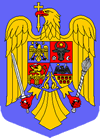|

For
every nation, the coat of arms- the supreme heraldic sign-
has a special importance. The images invokes the country's
history, through which its tradition last forever and the
signification raise the national feeling.
In many national coat of arms,
the constitutive elements are faithful to the national history,
being unanimously recognized by all citizens. Such noble symbols
are not only based on laws or decrees. There are, in the same
manner, the essence of ideals and aspiration of the citizens,
their common thoughts.
In Romania, the whish for a
representative, synthetic coat of arms dates back to the beginning
of XIXth century. It lead to the establishment of a brilliant
team of specialists in heraldic, that gathered remarkable
personalities of Romanian science. In the moment when the
State Archive was established and the studies developed, the
experts identified the counties, provinces' coat of arms.
After 1859 it was raised the
issue of a representative coat of arm.
In 1863 was found the solution of reuniting the traditional
symbols of the Romanian Land ( golden vulture with a cross)
and Moldova ( an aurochs with a star between its horn).
Afterward, in 1872, the national
committee for heraldic proposed a coat of arm by combining
the traditional symbols of the Romanian provinces: Romanian
Land, Moldova, Bucovina, Transylvania, Maramures, Crisana,
Banat and Oltenia.
The coat was adopted by the
Romanian Government and was used until 1921, when, following
the Great Union in 1918 the new coat of Great Romania was
created, by attaching the symbols from 1872: the sign of Hohenzoller
House (s royal European house with origin in the Middle Age).
It gave Romania four kings:
Carol I, 1866-1914, the one whom transformed the country into
a royalty in 1881, established the Romanian crown (made from
gun steel captured during the Independency war) and two dolphins
with lifted tails, symbolizing the Black See.
Romania's coat of arms was replaced
in 1947- when, under the pressure of soviet troops, the Popular
Republic of Romania was proclaimed- by a decorative effigy
symbolizing the richness of the country, framed by wheat ears,
with a background of a sunrise and in the upper part a red
star.
Shortly after the revolution
from 1989 Romania needed a new representative coat of arm.
In fact, the first symbol of the revolution was the whole
in the flag, from which the communist star was removed.
The committee for heraldic worked
intensely, submitting the Parliament two models, which were
finally combined. The result is the actual design, adopted
in September 10 1992.
The Romanian coat of arm has as central element the golden
vulture carrying the cross. Traditionally,
this vulture appear on the coat of arms of Arges county, city
of Pitesti and Curtea de Arges. It symbolize the Basarab dynasty
. the vulture, the symbol of Latinity and first rank bird
in heraldic, symbolize the courage, firmness, fly toward the
heights, power and greatness. It is also on the coat of Transylvania.
The shield it stays on is blue,
symbolizing the sky. The vulture holds in its claws the sign
of suveranity: a scepter and a sword, the letter remembering
of Stephan the Great, called " Christ Knight", the
scepter invokes Mihai the Brave, the first unificator of the
Romanian Lands.
On the bird's chest there is a coat of arms divided in four
with the symbols of the historical Romanian provinces, as
well two dolphins symbolizing the Black Sea.
In the first sequence there
is the coat of Romanian Land on blue: a vulture holding a
golden orthodox cross its peak, followed by a golden sun at
the right side and a golden new Moon at the left side.
In the second sequence there
is the traditional coat of Moldova: a black aurochs with a
cross between its horns, a five petal rose in the right side
and a half moon on the left, both of silver.
The third sequence presents the traditional coat of Banat
and Oltenia: above the waves a yellow bridge with two arches
(symbolizing the bridge across the Danube of Traianus), from
where a lion emerge holding a saber in its front paw.
The fourth sequence presents
the coat of Transylvania, Maramures and Crisana: a shield
divided in two by a thin line: above, on a blue background,
there is a black vulture with golden claws, a golden sun on
the right side and a half moon on left; below there are seven
notched towers, placed in two registers, in the first four
towers, in the second three towers.
There are, as well, represented
the adjacent territories of the Black See, on a blue background:
two dolphins placed head below.
|

